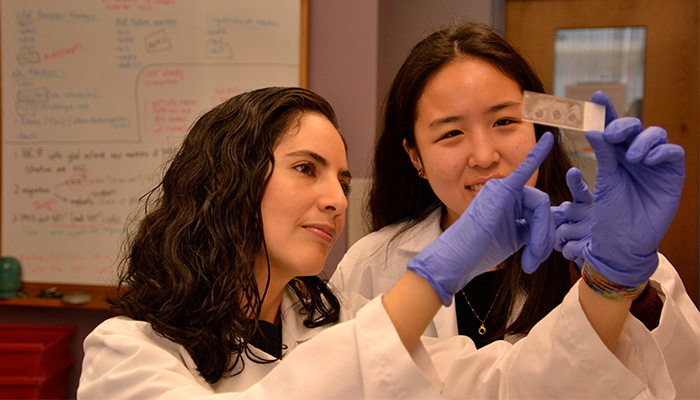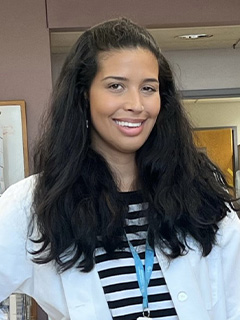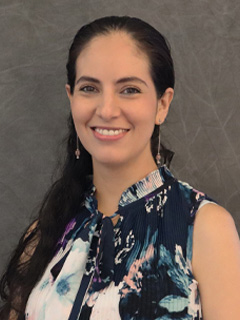HOW CAN WE HELP YOU? Call 1-800-TRY-CHOP
In This Section
CHOP’s Bridge to Faculty Program Forges a Path to Academia for Underrepresented Scientists

Zila Martinez-Lozada, PhD, (left) with undergraduate research scientist Isabella Song
By Lauren Ingeno
Growing up in the Nicetown section of North Philadelphia, Amaliris (Ama) Guerra, PhD, experienced severe asthma attacks that regularly sent her to the hospital. She often shared a room with a patient who had sickle cell anemia — an inherited blood disorder that disproportionately affects Black people.
That early exposure to the disease sparked a lifelong interest. Despite her own health issues, which led to regular absences from school, young Ama maintained top grades and a curiosity about science. Today, Dr. Guerra is a research scientist and faculty member in the Division of Hematology at Children's Hospital of Philadelphia Research Institute, where she is searching for new biological targets to treat sickle cell disease and other blood disorders.
Formerly a postdoctoral fellow at CHOP, Dr. Guerra is part of an inaugural pair of scientists selected to participate in the Research Institute's Bridge to Faculty Program.
Its goal is to prepare trainees from historically underrepresented groups for tenure-track faculty positions. Similar to the mentored phase (K99) of the National Institutes of Health's Pathway to Independence Award, the Bridge to Faculty program provides a competitive salary, research training, and professional development that will put postdoctoral fellows on the competitive and rigorous path to professorship.
"This is a unique training experience designed to prepare exceptional senior-level trainees to be competitive on the tenure-track job market," said Paulette McRae, PhD, associate director of Specialty Programs and Diversity in the Office of Academic Training and Outreach Programs at CHOP's Research Institute. "The program not only focuses on scholars getting positions, but simultaneously provides them with the tools needed for success as they launch their independent academic careers."
Treating Anemia

Amaliris (Ama) Guerra, PhD
For Dr. Guerra, leading a research group is an opportunity to give back to the community that nurtured her interest in biomedical research.
"I've lived in Philadelphia my entire life," Dr. Guerra said. "I know so many people with sickle cell disease who cannot afford curatives. Maybe I can come up with something that will improve the quality of someone's life, even if it doesn't necessarily cure them, in a way that is accessible."
Dr. Guerra's journey into academia began at Roberto Clemente Middle School in North Philadelphia. Her interests in computer science earned her an award from the City of Philadelphia and later, admission to the reputable Central High School. During high school, she was in Philadelphia's foster care system while continuing to succeed academically. She went on to study biology at Temple University, and her professors encouraged her to apply to the National Science Foundation's (NSF) Bridge to the Doctorate Fellowship Program.
With her acceptance to the NSF program, Dr. Guerra undertook a research project at the University of Pennsylvania, where she was introduced to Jean Bennett, MD, PhD, a pioneer in retinal gene therapies. That gene therapy experience led Dr. Guerra to CHOP, where she became a postdoctoral researcher in the lab of Stefano Rivella, PhD. Dr. Rivella is using a genus of retroviruses as a tool to modulate gene expression and treat sickle cell anemia, as well as β-thalassemia, a blood disorder that reduces hemoglobin production.
In 2019, a pre-clinical study led by Dr. Guerra found that the protein thought to be responsible for the therapeutic effects of luspatercept-aamt injection — a first-in-class medication to treat anemia — was not necessary to improve the disease. Therefore, the mechanism of the drug remains unknown.
Dr. Guerra's current research is focused on investigating how to fine-tune the immune system to deliver iron in a way that will safely increase red blood cell production in patients with thalassaemia, who are at risk of iron overload.
Throughout her time at CHOP, Dr. Guerra has been dedicated to creating opportunities for young scientists from underrepresented groups. That's included teaching at the Community College of Philadelphia and serving as chair of Postdocs for Diversity in Science.
She credits the Bridge to Faculty program with allowing her to stay in academic science, which has been a lifelong dream.
"I'm the product of all of these Philadelphia pipeline programs intended to create opportunity for people like me and to diversify academia. That has weight," she said. "Now I get the opportunity to do science as a real job, which is something that doesn't exist for a lot of people."
Tiny, Beautiful Cells

Zila Martinez-Lozada, PhD
Zila Martinez-Lozada, PhD, was similarly drawn to science at an early age. As a young girl growing up in Mexico City, she watched the underwater adventures of Jacques Cousteau on repeat and had dreams of becoming a marine biologist.
But as an undergraduate at Universidad Autónoma Metropolitan, her passion switched from the wonders of the ocean to those that are invisible to the naked eye.
"I just loved all of the tiny things that I could discover with the microscope," Dr. Martinez-Lozada said.
After graduating with highest honors, she decided to apply for a Master's degree program in genetics and molecular biology at CINVESTAV – one of Mexico's premier research institutions, and where she eventually went on to also earn her PhD. While at a conference, she met Michael Robinson, PhD, a professor of Pediatrics at CHOP who studies the transport of glumate, the main excitatory neurotransmitter in the brain. Impressed by Dr. Martinez-Lozada's body of work, Dr. Robinson eventually recruited Dr. Martinez-Lozada into his lab as a postdoctoral researcher.
At CHOP, Dr. Martinez-Lozada studies the communication of cells in the brain using a combination of cell culture microscopy and transcriptomics, a technique used to study a cell's RNA molecules.
Astrocytes are one of the main focuses of her research. A type of glial cell in the central nervous system, astrocytes outnumber neurons and are responsible for blood flow, as well as regulating synapse formation and synaptic transmission. They also participate in the formation of the blood-brain barrier, and provide metabolic support to neurons, among other functions.
One of her recent studies, published in Neurochemistry International, found that reciprocal communication is required to induce maturation of astrocytes and endothelial cells, which line the blood vessels. The results advanced the understanding of astrocyte biology, which has implications for treating many neurological diseases and psychiatric disorders.
"The brain is such a complex organ," Dr. Martinez-Lozada said. "We've known that there is a lot of neuron diversity, but we're just now starting to recognize that the other cell types in the brain — for example, astrocytes — are also heterogenous."
Basic science research, she said, is key to unlocking new treatments and eventual cures for diseases such as epilepsy, Alzheimer's, and Parkinson's.
"If we want to cure neurodegenerative diseases, we really need to first understand the molecular mechanisms of how cells in the brain communicate with each other, and then how that communication breaks down during disease," she said.
As a Latin woman and an immigrant, Dr. Martinez-Lozada said CHOP's new Bridge to Faculty program has allowed her to continue to pursue her dream of becoming a professor, and she is grateful that the program is opening more doors to diversify the field of biomedical research. Dr. Martinez-Lozada is also a mother, and that's a title she takes just as seriously as scientist. She sees herself as an example for others who want to pursue academic careers and raise children.
"You can do it; you just need to find your own balance," Dr. Martinez-Lozada said. "I want to be a role model for other women who, like me, have been told that they need to choose between their dreams and starting a family. Yes, there will be some challenges, but we can do both."